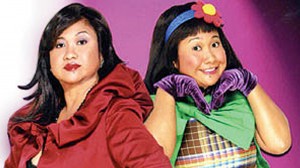“KIMMY DORA and the Temple of Kyeme”—that’s quite a mouthful for a movie title—and the film itself turns out to be a similarly gargantuan production to appreciate and “masticate.”
In its earnest effort to be bigger and better than the first “Kimmy Dora” movie, the sequel has perhaps inadvertently become too big, frenetic, campy and shrill, ending up as a messy mix of comedy, horror, travelogue, musical, special effects and what-have-you.
Most unfortunate of all is the production’s tendency to fall so in love with its “cute” and “clever” visuals and plot and character curlicues that it sometimes neglects to remember its main reason for being—namely, to make people laugh. —Hopefully, a lot.
Because it’s forgotten that less is more, the sequel is too grandiose and complicated for its own good, and ends up being not as much of a viewing treat as the smaller original production.
Bigger budget
That’s quite ironic, given the new film’s bigger budget and more expensive production values, which have turned out to be comparatively—devalued. —That’s decidedly food for thought for its makers—that is, if they agree that there’s a problem with the sequel, in the first place.
The new movie’s plot has it that Kimmy loves farmer Zanjoe Marudo, while Dora’s squeeze is none other than DingDong Dantes. —But, they are prevented from getting hitched by a curse that has been in effect ever since the girls’ Korean forebear reneged on his pledge to marry his first love (Alodia Gosiengfiao), who pined away and tragically died, becoming an evil, avenging ghost that’s bent on wreaking havoc on Kimmy Dora’s unacceptably happy existence!
The ghost subplot may have been initially interesting, but it’s developed in so overblown and extended a fashion that it sometimes threatens to upstage the rest of the movie. Worse, the horror element on which it rides distracts the movie’s makers (director Joyce Bernal, et al.) so much that they neglect to make the proceedings consistently funny.
In fact, the movie’s last third is bogged down by two extended “battles” between the horrifically vengeful ghost and the sisters whom it wants to “punish.” This slows down the rising action needed to make the movie’s denouement appropriately empathetic and exciting—which could be why a big musical number has been appended at film’s end, perhaps to belatedly remind the viewers that this is supposed to be a fun-filled flick!
Two characters
Eugene Domingo works hard in this production and achieves a clear delineation between her two characters, but her twin portrayals are too overwrought, shrill, campy and “pushed” to be delightful and warmly empathetic.
In fact, after all of the movie’s shrill goings-on, it’s a real relief to watch the relatively simpler and smaller portrayals turned in by Dingdong and Zanjoe, who don’t feel that they have to hype and punch up their acts to compete with their bigger and louder-than-life costar. —Indeed, less is more, and this well-intentioned but overblown sequel is—way too much.



